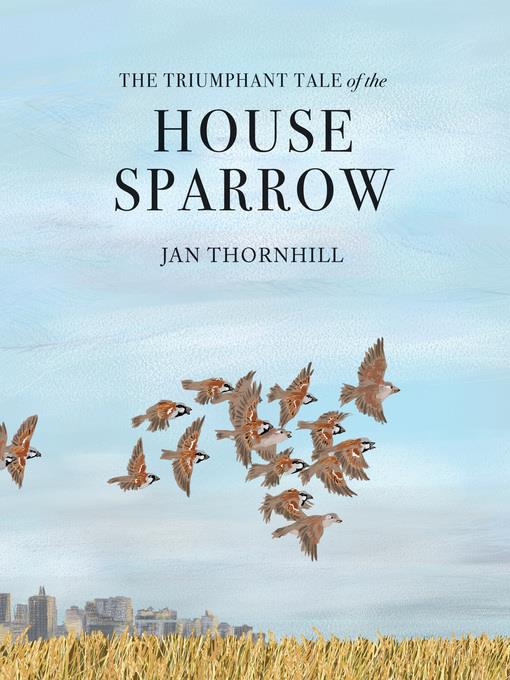
The Triumphant Tale of the House Sparrow
فرمت کتاب
ebook
تاریخ انتشار
2019
Lexile Score
1010
Reading Level
4-5
ATOS
6.1
Interest Level
4-8(MG)
نویسنده
Jan Thornhillناشر
Groundwood Books Ltdشابک
9781773062914
کتاب های مرتبط
- اطلاعات
- نقد و بررسی
- دیدگاه کاربران
نقد و بررسی

Starred review from March 1, 2018
Gr 3-6-Thornhill returns to questions on adaptation, conservation, and extinction, all raised in her 2016 award-winning title The Tragic Tale of the Great Auk, but here posed in a different light-one of triumph. The narrative pieces together the House Sparrow's long history, from around 12,000 years ago to the present day, to better understand how a creature so reviled still managed to adapt and survive in great numbers. Thornhill's precision in describing how the petite bird could be ruthlessly exterminated by people and, at the same time, be adored by them, her careful prodding of the dissonance between these two realities, is truly absorbing. What emerges is a complex, dark comedy of human behavior and a tenacious avian species, one with very real-and, as Thornhill argues, often ignored-consequences. Regarding their decline in North America, Thornhill asks: "What if the culprit is something that is as unhealthy for humans as it is for the House Sparrow?" The message is subtle but clear: our fates are intertwined. Thornhill's masterly digital art invites repeated viewing. There is death (and a bit of gore) as well as quiet, almost tender scenes, such as a small flock eating alongside cows on a train. The palette of rich greens, reds, and browns affirm the theme of vitality-and a story not yet finished. VERDICT An exceptional selection for nonfiction collections; use it to deepen discussions on the relationship among humans, animals, and the environment.-Della Farrell, School Library Journal
Copyright 2018 School Library Journal, LLC Used with permission.

Starred review from March 15, 2018
An examination of perhaps "the most despised bird in human history!"In this masterfully conceived and beautifully illustrated picture book, Thornhill examines a bird whose history is in some ways the opposite of her previous bird study, The Tragic Tale of the Great Auk (2016). She examines ways in which the house sparrow's ancestors adapted to changing human environments, starting with early agriculture in the Middle East through construction of cities that provided "nesting cavities in buildings, plenty of grain, and insects to feed its hatchlings." Although hunted as a pest, sparrows persisted and spread all over the world. They stowed away to Britain in Roman ships and were eventually carried to New York City and across the United States by migrants, living on grain used for livestock. The population fell dramatically when horse transportation declined and even more in recent years when food supply and nesting sites were drastically reduced due to modern building methods. Thornhill advocates careful analysis of this decline, given the house sparrow's unique ability to adapt to a fast-changing environment. She places her text against meticulously painted double-page spreads that depict the birds piled up for pies in an old Dutch kitchen, in a boxcar with cattle heading west, and succumbing to Mao's anti-sparrow campaign.Superbly designed nonfiction with a powerful environmental message. (map, glossary, list of adaptive species, resources, references) (Informational picture book. 9-14)
COPYRIGHT(2018) Kirkus Reviews, ALL RIGHTS RESERVED.

Starred review from May 1, 2018
Grades 2-5 *Starred Review* Pigeons, breathe a sigh of relief because for once the despised bird being discussed is the common House Sparrow. This bouncy brown ball of feathers will be familiar to all readers, so much so that they've probably given it very little thought. In a rather ingenious move, Thornhill (The Tragic Tale of the Great Auk, 2016) uses this unassuming figure as an entry point to discuss adaptation, invasive species, and humanity's role in shaping the environment. The history of the House Sparrow is closely tied to that of human civilization, and Thornhill consistently shows readers the link between this grain-loving bird's evolution and global migration with the spread of agriculture. Highly adaptable and fecund, House Sparrow populations quickly boomed alongside human settlements, starting in the Middle East and eventually spreading to every continent but Antarctica. This also meant that these chirpy fellows soon became a nuisance, particularly to farmers faced with decimated crops. Painting-like digital illustrations reveal various cultures on which House Sparrows left their mark, from their appearance as Egyptian hieroglyphs to children's jobs as sparrow catchers in England. As pesky as sparrows can be, Thornhill highlights their important role in insect control and as indicators of environmental health. Her engaging and informative avian history bestows worth upon the sparrow's feathery back, recasting it from villain to valuable ally.(Reprinted with permission of Booklist, copyright 2018, American Library Association.)

























دیدگاه کاربران